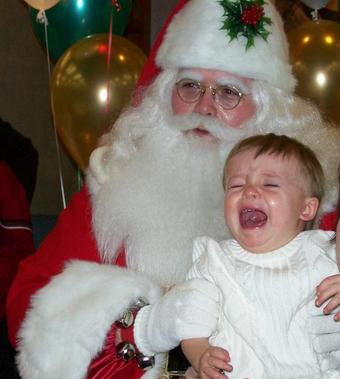This blog keeps to the straight and narrow much of the time, by which I mean we cover photojournalism with the occasional art photo or advertisement thrown in. We don’t range across Flickr, YouTube, MySpace, and the rest of the digital spectrum, much less put up snapshots from our own social networks. But one of the characteristics of media (and not just in the digital age) is that they all flow into one another. So it is that the Chicago Tribune website is inviting people to send in their snapshots of kids who are scared of Santa. And people do:
Cute, huh? Actually, I don’t think so. This photo probably is a good example of how one’s emotional response to images depends on context. The parents can chuckle because they know that this behavior was momentary and aberrant—the kid was fine in a minute and had lots of fun with the Santa myth otherwise.
It’s also a good example of why there should be some distinction between private and public media. Snapshots do many things, and photojournalism does many things, and they often can overlap and at times each do the work of the other. But you don’t have to look at many snaps to be relieved that they are not in the paper every day.
What interests me about these Santa images is that something does happen when they are collected for public viewing. Not one or two, but over a hundred and counting. Images like this:
And this:
And that’s more than enough, isn’t it?
The question arises, what does the series of images show that might be overlooked in any one? The answer is, the social form–that is, the custom, and who it serves, and what it costs. The visit to Santa is revealed to be something done not so much for the kids as for the adults. Frankly, the kids would never miss it, don’t need it, and in some cases would be better off without it. And isn’t this a lesson in the tyranny of social forms? A very, very minor example, of course, but an example nonetheless of how people can be pushed into fixed scenarios before they are ready for what social goods might be conferred there. You might say that the visit to Santa is the first step toward middle school.



It’s perplexing… but by this I’m thinking not so much of the photos, but the spin you’ve put on it.
You say yourself at the outset that “the Chicago Tribune website is inviting people to send in their snapshots of kids who are scared of Santa.” So people are hardly going to send in other photos, of which there are probably just as many if not more, of kids displaying signs of incomprehension, indifference, or even pleasure, are they?
I only found this out a short while ago (I don’t have children, and as such I have no good reason to frequent Santa’s Grottos anymore) so I don’t know how recently it happened, but in the UK children are apparently no longer allowed to sit on Father Xmas’ knee. I doubt very much that this will necessarily make the big beardy stranger in the red suit (courtesy CocaCola apparently, he used to be dressed in green before) any less daunting a prospect for kids feeling tired and emotional during/after long forced seasonal shopping sessions with their families. But I find the implications of the ban more horrifying as a “tyranny of social forms”. And for the same reason, the title of this post is horrifying too.
Personally, I’ve always found Santa a bit sinister, but in a similar way to finding clowns sinister. But from there to labelling them boogeymen seems ridiculously extreme.
For me, the question that arises is, what is the Chicago Tribune hoping to achieve by specifically inviting people to publically share these family photos? If it’s the kind of critical, kneejerk ban that has already happened in England then, judging by this blog post, I say it’s a bullseye.
F:lux: I’m not sure what the Tribune is after, but the collection is odd. It’s not even “unusual Santa photos”; they want the kids to be miserable. If that’s good for a laugh, it’s still at someone’s expense. The value for me was that it showed how there can be something sinister to forced holiday cheer and similar rituals. We can’t live without ritual, but we shouldn’t have to suffer them needlessly either. (The pragmatic solution to the Scary Santa problem is simple: wait until the kids are a bit older and respect their right to say no.) The title of the post was meant to be ironic but I have to admit that the irony is unstable. Any ambiguity reflects my lack of resolution about the meaning of the archive, but only that. I have no interest in banning Santas or otherwise lending any support to another case of media panic and fear mongering.
Your point that folks are prompted to send in the images is a good one. What I find stunning is that (a) people actually keep and save these photographs, and (b) are then willing to put them in a public space.
Interesting. And the response.
I’m thinking that if readers were asked to send in their photos of their children screaming in pain or anguish at /anything/, they would do it. The amateur video camera compilations of babies falling off swings and tripping, slipping, bawling, seem to dominate the aesthetic.
Santa? My small children were disconcerted at the down-the-chimney myth. After being told by all and sundry never to talk to strange men, it seems unreasonable to expect them to be thrilled at the prospect.
They currently have just short of 300 submissions. The introduction to the second set (“More Scared of Santa”) concludes with this jolly line: “Enjoy the holiday howls!”
It’s one thing to take the picture, another to keep it, a third to send it in. I assume all are innocent. It’s a fourth thing to solicit and publicize the photos; that is more likely to reflect mixed motives. As one shifts from the snapshot in a family album to circulation via the public media (including this blog), the lens changes from family history to social ritual to a little wrinkle in the public culture. Each one merits discussion.
Definitely.
Point taken. I’ve just come back in the hopes of tempering, or perhaps better explaining, where the ranty comment I posted yesterday came from, now that I’ve had more time to think about it.
Where usually I find the analyses of imagery discussed here measured and edifying, in this particular case it did bother me that, recontextualised by a quite shocking title, there seemed to be little to no room to interpret the photos presented in any other way than that offered by the author of the post. This kind of (and please excuse me here, as I can’t think of a better word) manipulation is more commonly used by sensationalist news tabloids I can think of, so I was surprised to encounter it here. But as a result it has provoked a great deal of thought for me, and as such I’m actually grateful.
Hey, thanks for the comeback. Although we often don’t respond (we do have day jobs), John and I really appreciate reader feedback. We want to be “measured and edifying” and also thought provoking although not sensationalist, and sometimes we’re not sure where to draw the line. Criticism and other comments help us work out our own style and our relationship with our readers.
“You might say that the visit to Santa is the first step toward middle school”–now there’s a frightenng image!
Let me add a little to this intriguing discussion. “Abuse” does seem to be the wrong word here, and, of course, it is not consistent with the analysis either. These children are unhappy, they are crying, but they are not suffering tragic damage. They are doing one of the things that all kids do–they are a little scared, they feel out of place, they are tired, they want to be somewhere else. In a certain sense, and in a particular way, they are just kids being kids.
So their unhappiness does matter, particularly collectively. I suspect that what it does most is to draw on the viewers’ sympathy. One response is to want to vicariously comfort these children, to help them feel better. So in this respect, the display of such photos in the Tribune could be an act of collective empathy–and one much more in keeping with the spirit of the holiday than the visit to the mall or asking Santa for more toys.
Not all family photos show smiling happy times. Perhaps the fact that there are so many of these pictures and that they are displayed so publicly helps in a small way to connect us to each other. We have all felt like these kids, we all care. Not an easy task to accomplish, especially at Christmas–a time of enforced ritual happiness and a celebration of consumer culture.
In that spirit, I suppose, I want to join another sentiment of these comments–thanks for the photos, thanks for the writing, thanks for the comments. This blog is an intriguing and thoughtful forum where people can talk well about important things. Thanks.
Okay, I’ll say it. Paedophilia. It’s a dipthong, I believe. Pedophilia is the correct spelling here.
There was enough discomfort among mothers of small children way back in my parenting timeframe of the 1970s (when the mere mention of child sexual abuse was absolutely taboo) to warrant the transmission of some level of anxiety, which in its turn would be transmitted to the child.
And although there’s been alarm and hype, of a level which has incited misplaced and pretty shameful mob attacks, that doesn’t mean that there aren’t, isn’t or weren’t occupations where it would be perfectly possible to have inappropriate contact with small children. So, when did some appreciation of some aspect of something to do with ‘Xmas’ depend on sitting tiny children on the laps of complete strangers, about whom we and the child, know nothing?
So yes, I too, appreciate all the comments here.
The richness of Web2/3 is the potential for dialogue, the journalistic equivalent of a soapbox with the holistic experience of audience participation. Discourse can be more than one way.
Oh gosh, I missed my main point.
It’s that given the above screaming nipper is one of ours, that we the great public submitted it, isn’t this also a celebration of our collective pleasure that our offspring are so acute?
We don’t really think Coca Cola taught the world to sing in perfect harmony, we don’t think a fairy tucked a shiny shilling under the pillow when our first tooth fell out. And our toddlers by association, don’t buy it either. We have to teach them to buy it. And we do.
I couldn’t understand some parts of this article , but I guess I just need to check some more resources regarding this, because it sounds interesting.
great stuff – cu
Yeah, you’re definitely overthinking this one.